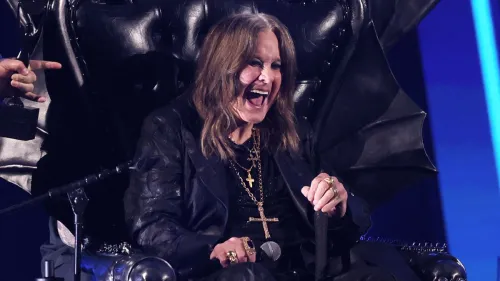The world has lost a rock legend. Ozzy Osbourne, the frontman of Black Sabbath and beloved “Prince of Darkness,” has died at the age of 76 following a long, public battle with Parkinson’s disease. His death marks the end of an era, not only in music but in the broader cultural story of resilience, raw honesty, and the very human fight against chronic illness. For more than five decades, Osbourne captivated audiences with his wild stage presence, his unmistakable voice, and later, his remarkable openness about his health.
While fans mourn the loss, many are also reflecting on his courageous and transparent fight against Parkinson’s—a condition that gradually robbed him of physical abilities but never dimmed his willpower. His story is one of pain, persistence, and personality, filled with challenges, breakthroughs, and emotional truths that helped destigmatize conversations around neurodegenerative diseases.

What Type of Parkinson’s Disease Did Ozzy Osbourne Have?
Osbourne wasn’t diagnosed with classic Parkinson’s but with a rare form known as Parkin mutation-related Parkinson’s, or Parkin Type 2. This variant typically presents at an earlier age and progresses more slowly than idiopathic Parkinson’s disease. Ozzy publicly revealed his diagnosis in 2020, though he had known about the condition since 2003, keeping it private for years while seeking multiple opinions and attempting alternative treatments.
Unlike most late-onset cases of Parkinson’s that are commonly linked to environmental and aging factors, the genetic aspect of Parkin Type 2 often involves mutations passed down from both parents. This made Ozzy’s case unique and provided insight into the complexity of Parkinson’s-related illnesses, where symptoms and progression can differ dramatically from person to person.
Ozzy Osbourne’s Parkinson’s Disease Symptoms: What He Endured
For years, fans noticed the signs long before the official announcement. Osbourne suffered from:
- Tremors and uncontrollable shaking
- Muscle stiffness and slowed movements (bradykinesia)
- Balance and coordination issues
- Speech changes and facial masking
- Fatigue and sleep disturbances
The symptoms intensified after a series of unrelated health issues, including a near-fatal staph infection in 2018 and a traumatic fall in 2019 that dislodged metal rods from a previous ATV accident surgery. The fall exacerbated his Parkinson’s symptoms, causing nerve pain that he described as “agony beyond words.”
In interviews, Ozzy candidly spoke about waking up in pain and needing help with simple tasks—harsh realities that painted a vivid picture of how debilitating Parkinson’s can become.
How Ozzy Osbourne Managed His Parkinson’s Disease
Managing his illness became a full-time endeavor. Ozzy pursued a multidisciplinary approach to his care, which included:
- Daily physical therapy and strength-building exercises
- Medication like Levodopa to regulate dopamine levels
- Holistic therapies including acupuncture and CBD oil
- Travel to Switzerland for specialized treatments
Sharon Osbourne, his wife and unwavering advocate, once disclosed that they visited a clinic overseas where Ozzy underwent cutting-edge stem cell therapy and experimental protocols not yet widely available in the U.S.

Beyond medical treatments, Ozzy leaned heavily on family support and personal grit. Even during moments when he could barely stand, he voiced his determination to keep performing. In 2022, he stunned fans with a surprise performance at the Birmingham Commonwealth Games—his voice steady, eyes sharp, despite physical limitations.
Ozzy Osbourne’s Prior Health Struggles: A Lifetime of Physical Trials
Long before his Parkinson’s diagnosis, Ozzy’s health history was marked by numerous setbacks. In 2003, he narrowly survived a serious ATV accident that left him with a broken collarbone, fractured vertebrae, and damaged ribs. His body was pieced back together with metal rods—hardware that became problematic decades later.
He also faced:
- A staph infection in his thumb (2018), requiring emergency surgery
- Flu complications and pneumonia (2019), which led to hospitalization
- Chronic bronchitis and respiratory issues linked to years of smoking
- Colonic polyps, spine issues, and blood clots
All these issues compounded his physical struggles and added complexity to managing Parkinson’s. Yet, through it all, he remained defiant, often quipping in interviews, “I’m not ready to go yet.”
The Truth About Ozzy and Sharon’s So-Called ‘Suicide Pact’
In a revelation that sparked global headlines, Sharon Osbourne once confirmed in an interview that she and Ozzy had made a mutual agreement years ago: if either of them developed a life-ending, severely debilitating disease with no quality of life, they would consider assisted suicide.
While tabloids sensationalized it as a “suicide pact,” the truth was more nuanced. It was not a plan but rather an emotional discussion about dignity, suffering, and end-of-life choices—a conversation many couples have but rarely admit publicly. Sharon clarified that they were not advocating for suicide, but rather for agency in moments where unbearable pain or terminal decline erased all autonomy.
This candidness reflected the deep love and brutal honesty that defined their relationship for over four decades. It was less about death and more about choosing life on their own terms—a philosophy Ozzy embodied until his final breath.
A Legacy That Transcends Music
Ozzy Osbourne’s death is not merely a loss to rock music; it’s a moment that calls attention to the millions living with Parkinson’s and other neurodegenerative diseases. According to the Parkinson’s Foundation, over 10 million people worldwide live with the condition, and that number is expected to rise as populations age.
By speaking openly about his battle, Ozzy helped erase the shame and secrecy that often accompanies such diagnoses. He gave a face to Parkinson’s—one with grit, humor, and humanity—and in doing so, he empowered others to confront their own battles with dignity.
His story teaches us that resilience isn’t the absence of suffering, but the refusal to let it define you.
Final Thoughts
Ozzy Osbourne’s life was chaotic, controversial, and unforgettable. But beneath the heavy metal persona was a man who fought relentlessly against the limitations of his body, a husband who remained deeply devoted, and a father who wanted more time with his family.
As tributes pour in from fans and fellow musicians alike, one thing is clear: Ozzy Osbourne didn’t just rock stages—he reshaped how we view chronic illness, aging, and vulnerability.
He may have sung about madness and mortality, but in his final act, he taught us all something about strength, humility, and heart.
Rest in peace, Ozzy. The world is quieter without you—but your roar will echo forever.
Also Read | Chronic Venous Insufficiency: Early Signs Women Must Know









